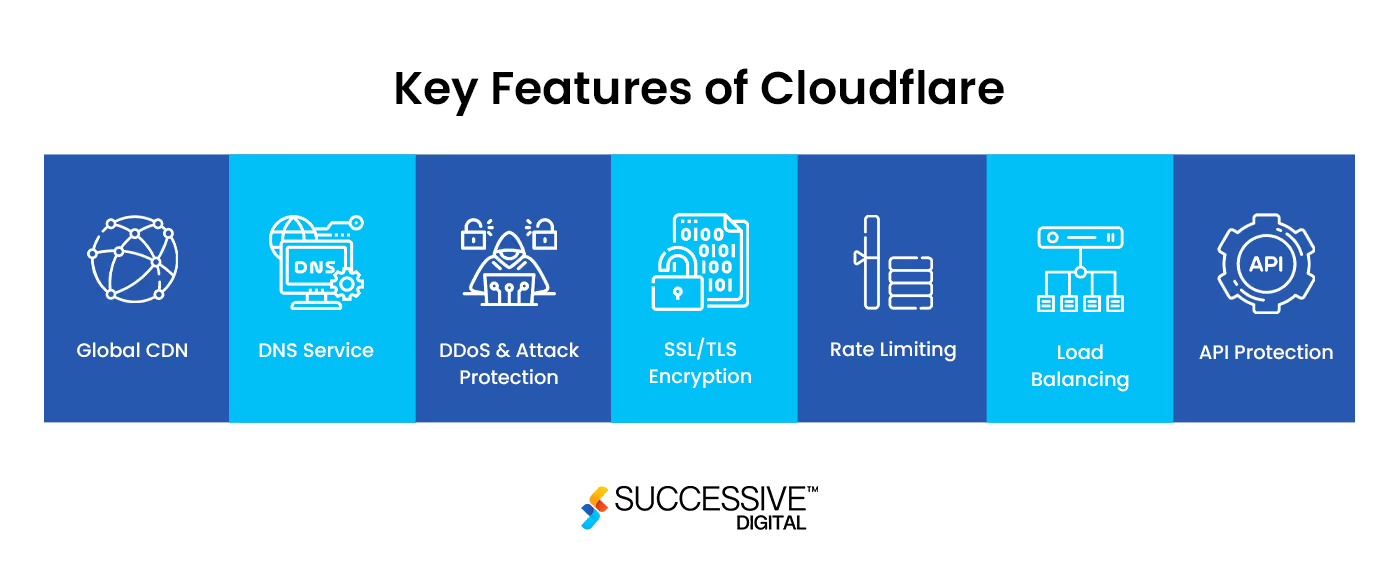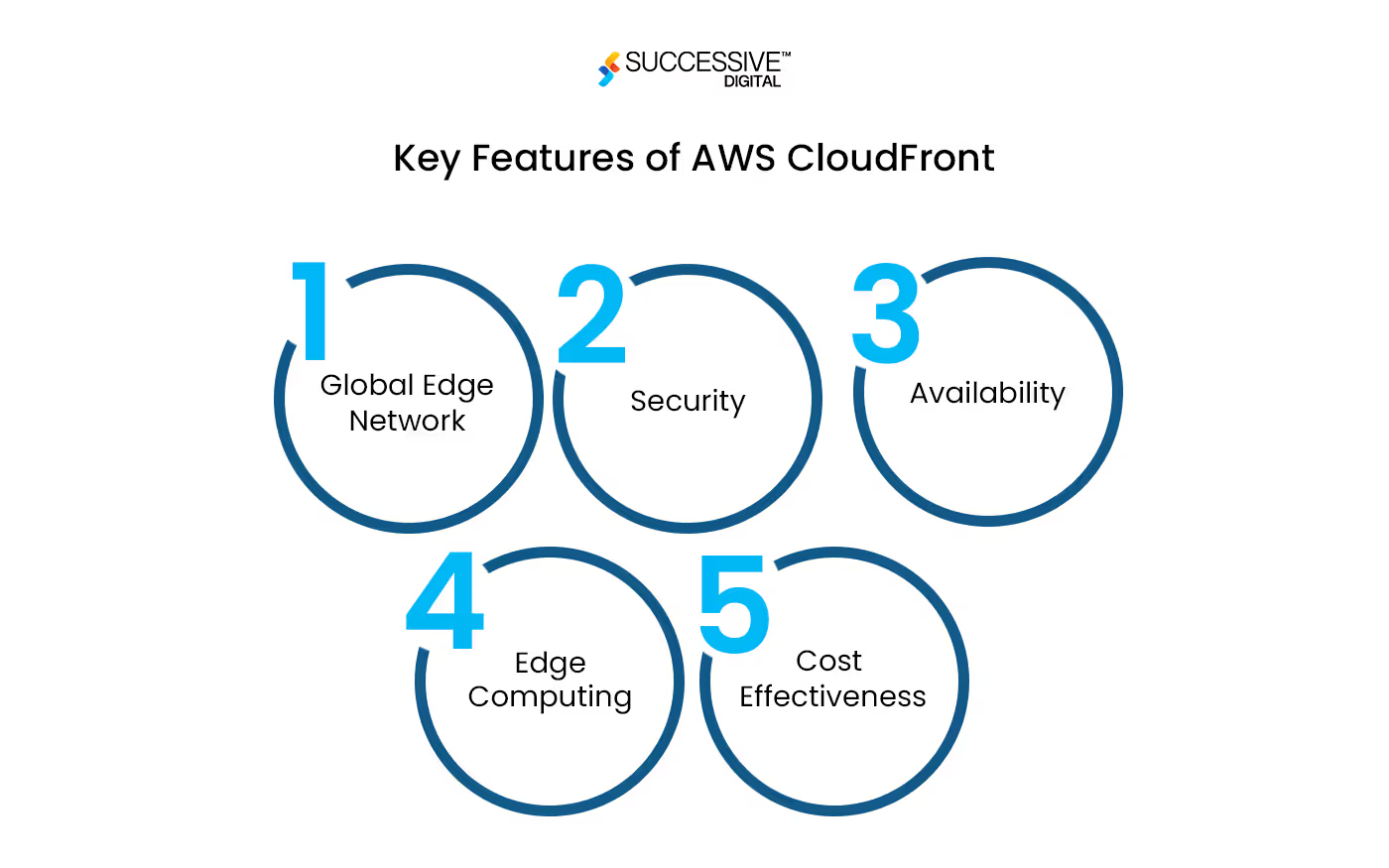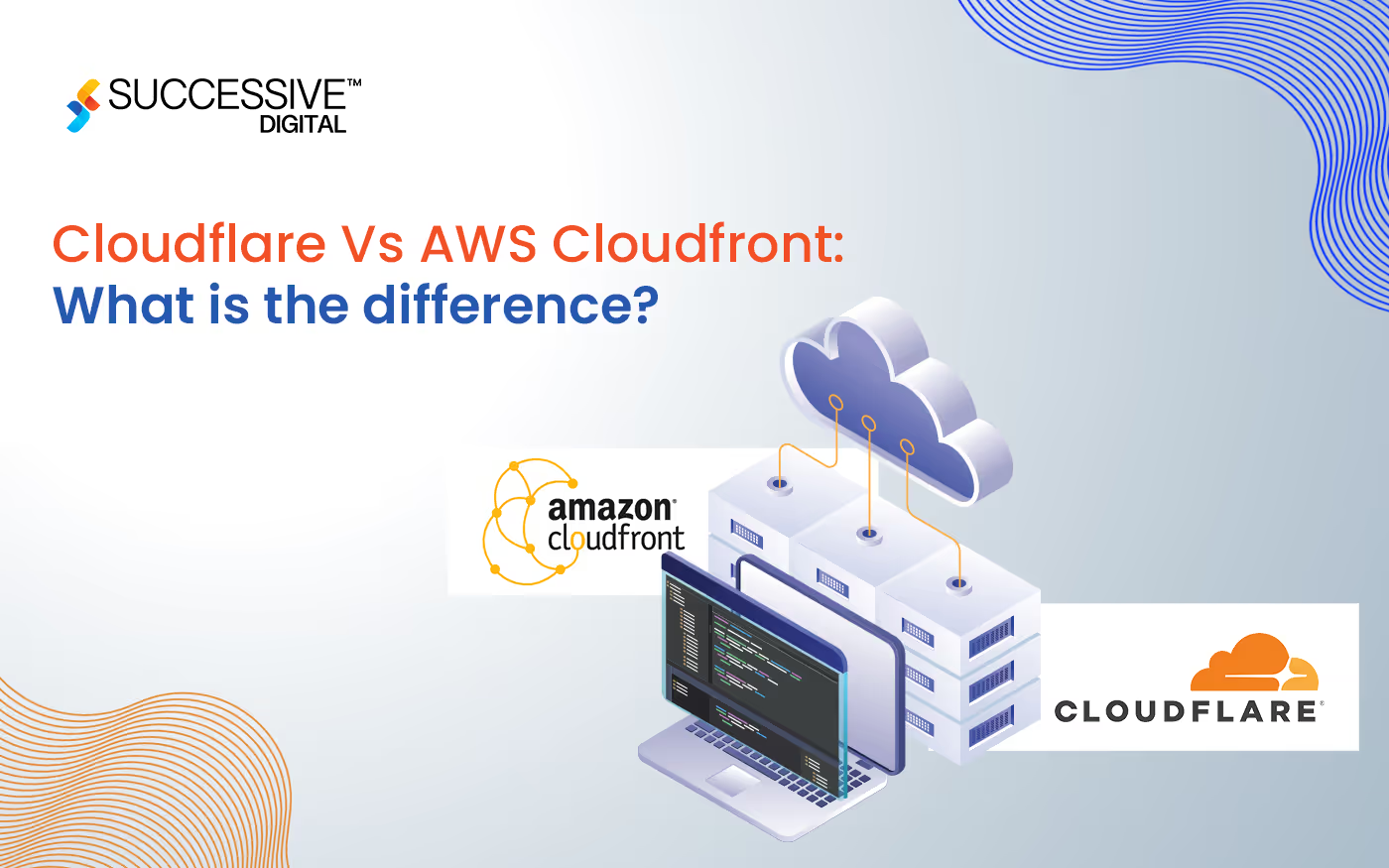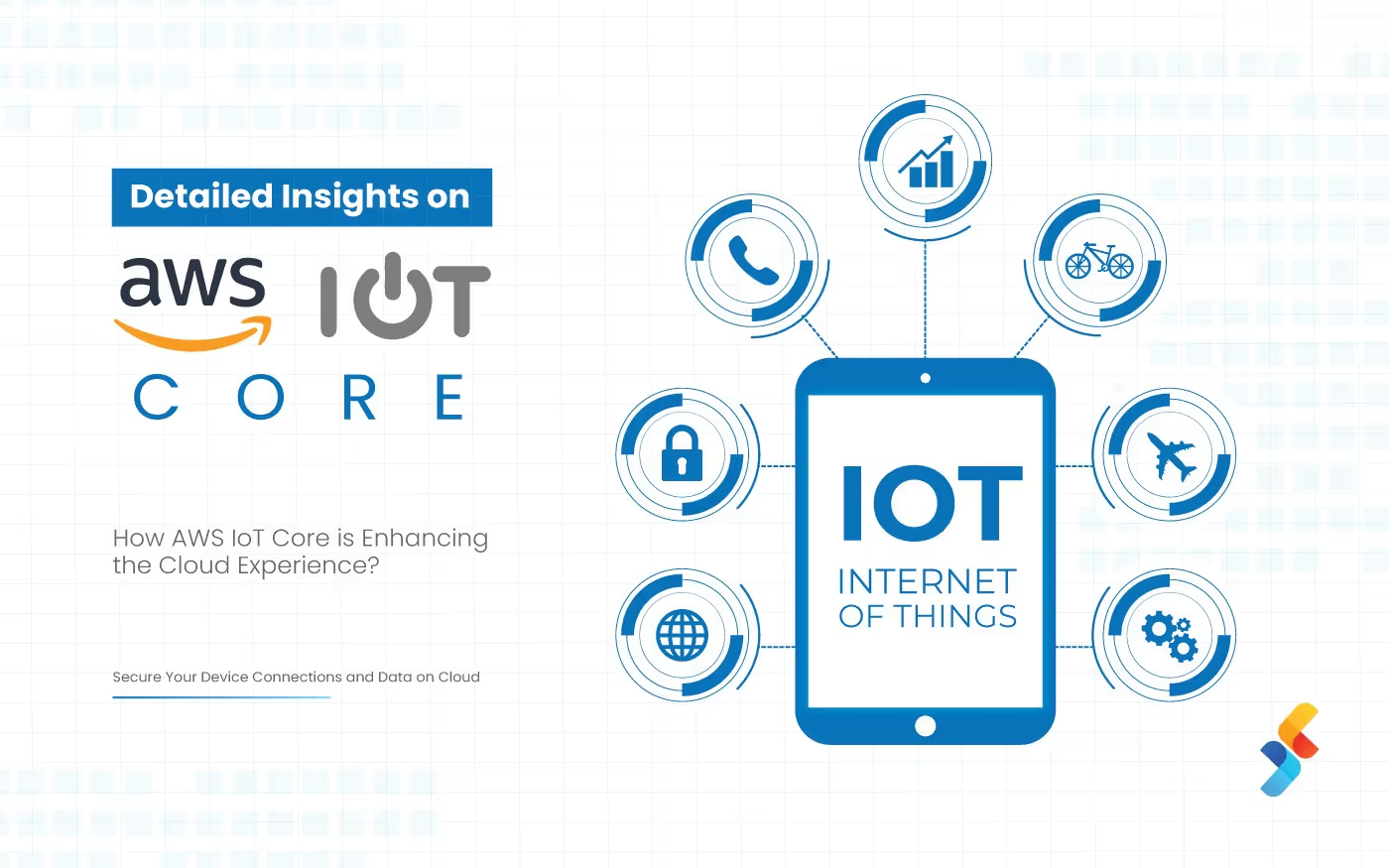Content Delivery Networks (CDNs) are becoming an essential tool for reducing cyber threats and improving web speed. Amazon CloudFront and Cloudflare are two widely used CDNs in modern business. They are the two most well-known and trustworthy CDNs. Apart from expediting the distribution of material and reducing load times, they can also yield significant advantages for your company. This article compares Cloudflare Vs CloudFront, outlining the features, advantages, and disadvantages of each CDN.
What is CDN?
CDNs are utilized globally, and industries like e-commerce, media/publishing, and SaaS enterprises use global content delivery networks the most for their daily operations. These businesses use content delivery networks (CDNs) to enhance website service performance, reduce traffic surge risks, increase scalability, and speed up load times. CDNs can do that by utilizing a network of nodes and servers dispersed among several internet backbones. CDN technology has been used since the early days of browser-based Internet access. When this technology started, it could only serve or cache static material like pictures, videos, CSS, and JavaScript. To read about AWS databases, refer to this blog: AWS RDS Vs Aurora: Everything You Need to Know. However, the modern iteration of CDN technology is a testament to its impressive evolution. It now handles dynamic content, which requires server-side or computational logic and is not cacheable. Examples are shopping carts, user comments on articles or blogs, and dynamic figures on websites like stock trading platforms—where prices must be updated constantly.
Why You Should Know About Content Delivery Network?
In today's digital age, where online presence is essential for organizations across industries, knowing the significance of Content Delivery Networks (CDNs) is crucial. CDNs are important in optimizing web content delivery, enabling fast and reliable access for users worldwide. By carefully distributing content over a network of servers, CDNs improve user experiences, reduce latency, strengthen security measures, and achieve cost savings. Understanding the importance of CDNs allows you to make informed decisions that maximize performance, improve customer satisfaction, and move your organization toward digital success. If you want to give your users a great experience when they land on your website, you must know about it. Some more reasons are jotted down below:
- It improves the user's web browsing experience by loading the site faster.
- Allows massive e-commerce and social media sites to manage high traffic levels more efficiently during peak hours.
- It helps to escape traffic congestion on Internet routes, allowing businesses to maintain their online presence during emergencies by choosing other paths to distribute content to users.
- It helps combat the most severe cyberattack that can strike websites: a distributed denial-of-service (DDoS) attack.
- CDN allows small and medium-sized websites to scale based on demand. CDN raises the bandwidth to prevent a website from experiencing response failures when there is a lot of traffic.
What is Cloudflare?
Launched in 2007, Cloudflare functions as a reverse proxy. It is a cloud-based platform that offers various services to help improve website performance, security, and reliability. Cloudflare functions as a Content Delivery Network (CDN), including DDoS protection, a Web Application Firewall (WAF), SSL/TLS encryption, load balancing, and optimization tools.Caching content on servers spread across multiple geographical locations offers website security and performance services that lessen the strain on local servers. Cloudflare's main product is an all-in-one solution for app scaling. Cloudflare's services improve user experience by lowering latency, guarding against cyber attacks, and enhancing website performance. It caters to businesses and website owners who want to develop a more secure, fast, and trustworthy online presence.
Key Features of Cloudflare
Cloudflare is an advanced solution that can help you sustain your customers for a long time. Below are the features of Cloudflare:
- Global CDN
Cloudflare offers services like global distribution, DNS support, and extra security and encryption features.
- DNS Service
Cloudflare's servers are dispersed throughout the world. Static and dynamic content can be cached close to the user's location. In 50 milliseconds, the Cloudflare network can reach 95% of the world's population. It may be found in 250 cities in 100 different countries.
- DDoS and Attack Protection
Cloudflare offers a strong DDoS defense. To be precise- it stops 86 billion threats daily.

- SSL/TLS Encryption
Cloudflare provides free SSL encryption. All traffic going through Cloudflare servers is encrypted against data manipulation and theft.
- Rate Limiting
Cloudflare's rate-limiting capability provides superior security against common web assaults such as DDoS, brute-force login attempts, API traffic surges, and cyberattacks targeting web APIs and apps.
- Load Balancing
Cloudflare dynamically selects the fastest servers and Internet routes to deliver content to end users. This geographically based architecture shields them from sluggish servers and clogged internet routes that worsen user surfing experiences.
- API Protection
Cloudflare's API Shield uses multilayer security measures and discovery to keep APIs safe. The all-in-one solution from Cloudflare is excellent if you value simplicity of setup and wish to utilize various services.
What is AWS Cloudfront?
Amazon CloudFront is a Content Delivery Network (CDN) service that accelerates the delivery of web content and assets by caching them in edge locations worldwide. CloudFront delivers material from the nearest edge point when users request material, lowering latency and improving load times. CloudFront has multiple AWS features, including global reach, content caching, security measures, interaction with AWS services, and real-time monitoring. Amazon CloudFront focuses on delivering a secure, worldwide CDN to ensure that your web app or website's static assets (such as photos, JS/CSS files, HTML files, and PDF documents) are provided as quickly as possible. It also includes security features to keep your site working dependably. If you want a CDN service that works seamlessly with other AWS services, Amazon CloudFront is an excellent choice, especially if you already have apps and services operating on AWS. It is a go-to solution for enterprises trying to improve web speed and deliver content consistently to a broad audience.
Key Features of AWS CloudFront
Cloudfront is a reliable product of Amazon Web Services and has been trusted by many businesses. Below is the jotted-down list of key features:
- Global Edge Network
Amazon CloudFront offers partnerships with Tier 1, 2, and 3 telecom operators worldwide. It operates a global network of 600+ points of presence and 13 regional edge caches in 100+ locations across 50 countries.
- Security
Amazon CloudFront provides robust security with capabilities such as threat defense via Amazon Route 53, AWS Web Application Firewall, and AWS Shield DDoS protection. It supports HTTPS connections with AWS Certificate Manager and automatic SSL/TLS certificate renewal. Most users can securely transmit all content and API traffic via HTTPS without additional fees. Furthermore, AWS WAF provides extra security features such as rate limiting and bot control to ensure comprehensive application security at scale.

- Availability
Amazon CloudFront is available through Amazon CloudFront Origin Shield and its redundancy mechanism. CloudFront Origin Shield caches material in many locations and fetches it from the origin only when necessary. Furthermore, by setting origin redundancy, Amazon CloudFront will fetch the requested content from the backup origin if the primary origin is unavailable.
- Edge Computing
Amazon CloudFront offers programmable and secure edge CDN computing capabilities via CloudFront Functions and AWS Lambda@Edge.
- Cost-Effectiveness
Amazon CloudFront is a cost-effective CDN service for a variety of reasons. First, it offers a variety of payment choices that are suited for the majority of clients. These include pay-as-you-go (with no upfront fees), the Amazon CloudFront security savings bundle, and bespoke pricing. Furthermore, Amazon CloudFront does not charge for data transfers between AWS cloud services and Amazon CloudFront for origin retrievals.
Cloudflare Vs AWS Cloudfront: How are they different?
We have already explored the features of Cloudflare and AWS Cloudfront separately; let’s further understand how they differ from each other:
- Data Delivery
As already mentioned, Cloudflare manages data via a reverse proxy architecture. Websites and apps are set up to use Cloudflare's nameservers instead of the default ones provided by cloud providers. Cloudflare servers process requests and decide how to route traffic. IT teams find Amazon CloudFront's distribution creation process easy. Instead of altering name server settings, they simply create distributions, or copies, of the material they intend to share. Administrators leverage the distinct URLs for these data distributions, a simple method to guide queries to the CloudFront CDN. The tool, based on the request's geographic origin, intelligently selects the server in the network to respond to a CloudFront URL request.Read more about Data Engineering here: Data Engineering: A Guide Explaining Every Aspect of IT.
- Granular Control
IT teams can utilize Amazon CloudFront's easy yet sophisticated data management tools to govern each component of their websites or apps. Cloudflare also provides fine-tuned content management features, but only through an API, which is more challenging to configure.
- Accessibility via URLs
While Amazon CloudFront material can only be accessed through defined URLs, Cloudflare does not require any particular URLs. This implies that Cloudflare's CDN can handle requests for websites such as "example.com." Instead, queries are sent through the CDN via something like "alongurlfullofrandomcharacters.example.com" when using Amazon CloudFront. Setting up Amazon CloudFront involves more sophisticated URL setups than Cloudflare, where all that's needed is pointing name servers in the correct direction.
- Distributed denial-of-service (DDoS) protection
Cloudflare provides additional functionality beyond a conventional CDN, such as anti-DDoS security through its Magic Transit feature. Amazon CloudFront is not designed to prevent DDoS; administrators must use AWS Shield instead.
When to Choose AWS Cloudfront?
You can choose AWS Cloudfront when:
- You are heavily integrated with Amazon Web Services (AWS) and want flawless compatibility.
- You value close integration with other AWS services to create a complete cloud ecosystem.
- Your primary focus is using the AWS infrastructure for content delivery and optimization.
- You need a worldwide CDN that can efficiently distribute content at minimal latency.
- You value scalability and the capacity to handle traffic spikes.
When to choose Cloudflare?
You can choose Cloudflare when:
- You're seeking a comprehensive CDN solution with robust security and optimization capabilities.
- You want a CDN that offers a wide range of security features, such as DDoS protection and WAF.
- You'll need a user-friendly platform that can support a variety of websites and applications.
- You value ease of use and a simple setup process.
- You're looking for affordable plans that include both free and paid choices.
Conclusion
Both Cloudflare Vs CloudFront provide trustworthy CDN services, but each has its advantages and disadvantages. Cloudflare stands out for its user-friendly interface, worldwide network, and cost-effectiveness, whereas AWS CloudFront provides comprehensive customization, seamless connection with AWS services, and precise analytics. The decision is based on unique requirements, platform familiarity, and budget concerns. With enough experience, Cloudflare and Amazon CloudFront can endure high traffic volumes and deliver dependable services. Even though their features and methods of operation differ slightly, both CDNs ought to be an excellent option for your company. They can manage spikes in traffic and improve your web services' general performance and speed. Still confused- Get in touch with us!
.avif)










.jpg)









